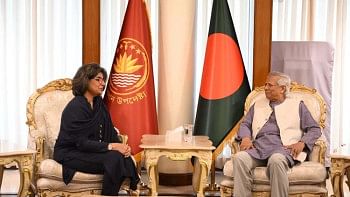Did Gen Zia abolish Sangsad's power?
The way Prime Minister Sheikh Hasina on Saturday spoke about the introduction of the Supreme Judicial Council seems to have put the blame squarely on military ruler General Ziaur Rahman for abolishing parliament's authority to impeach the apex court's judges by introducing the new system.
She pointed out that after seizing power General Ziaur Rahman brought in the Supreme Judicial Council by amending the constitution through a martial law proclamation in 1978. This part of her statement is true.
But it does not reveal all the historical facts about the introduction of the Supreme Judicial Council. This also does not make it clear how parliament's power enshrined in the constitution of 1972 to impeach judges was scrapped.
The premier avoided mentioning the crucial fact that it was none other than the government led by Bangabandhu Sheikh Mujibur Rahman which curtailed parliament's power to impeach Supreme Court judges through the controversial fourth amendment to the constitution in January 1975.
Instead of parliament, the president alone was empowered with sweeping authority to impeach a Supreme Court judge on grounds of misbehavior or incapacity. One other provision included in the constitution was that a judge would be given reasonable opportunity of showing cause against the action proposed to be taken against him for his removal. That is all. There was no other specific provision for conducting any investigation to prove the alleged misconduct of a judge.
But when parliament retained the authority to impeach judges, there was a specific constitutional provision of enacting a law for regulating the impeachment procedure and for investigation and proof of the misbehaviour or incapacity of a judge.
This provision was, however, abolished by the constitution's fourth amendment through which the country switched over to the presidential form of government, with the president enjoying unlimited powers.
And the most interesting part of the story is that the fourth amendment removed then elected President Mohammad Mohammadullah from office and declared Bangabandhu Sheikh Mujibur Rahman as the new president for a five-year term without any election.
Bangabandhu, when he was prime minister before assuming the office of president in the newly introduced presidential form of the government, was also a member of parliament. But when he assumed the office of president, his parliamentary membership became vacant, turning him into a non-elected individual in the presidential office with unlimited state powers, including the one related to the impeachment of Supreme Court judges through issuing orders.
The fourth amendment also extended the tenure of the first parliament formed in early 1973 by five years from the day the constitutional amendment took place. There was no need for holding a fresh election enabling people to elect their representatives.
For his part, General Ziaur Rahman after seizing power abolished the president's authority to impeach Supreme Court judges. Gen Zia, who declared himself president in 1977, brought in the Supreme Judicial Council by amending the constitution through a martial law proclamation in the exercise of his powers as chief martial law administrator.
Many political analysts say Zia had empowered the Supreme Court by introducing the Supreme Judicial Council system in the expectation of some favours from the country's apex court since he was governing the country illegally. In so doing, he was following the Pakistani model introduced by General Ayub Khan, Pakistan's first military ruler, in the late 1950s.
In 1979, the constitution's fifth amendment, passed in parliament by the Zia's regime, ratified and validated all constitutional changes, including the introduction of the judicial council. The Supreme Court later declared the fifth amendment illegal but condoned the provision for the Supreme Judicial Council.
The provision was regarded as a product of martial law until the democratic government led by the Awami League introduced it afresh through the fifteenth amendment in 2011.
Sheikh Hasina's government in 2011 did not raise the question of whether or not the Supreme Judicial Council went with parliamentary democracy. The prime minister now argues, however, that this system goes against the spirit of parliamentary democracy since the people are the repository of all powers in such a political system.
And, in her view, the people's representatives should get back the power to impeach judges. But the more critical question is: can the current parliament claim to be comprised of people's representatives when more than half of its members were elected unopposed, without a single vote being cast, in the January 5 election?

 For all latest news, follow The Daily Star's Google News channel.
For all latest news, follow The Daily Star's Google News channel. 



Comments